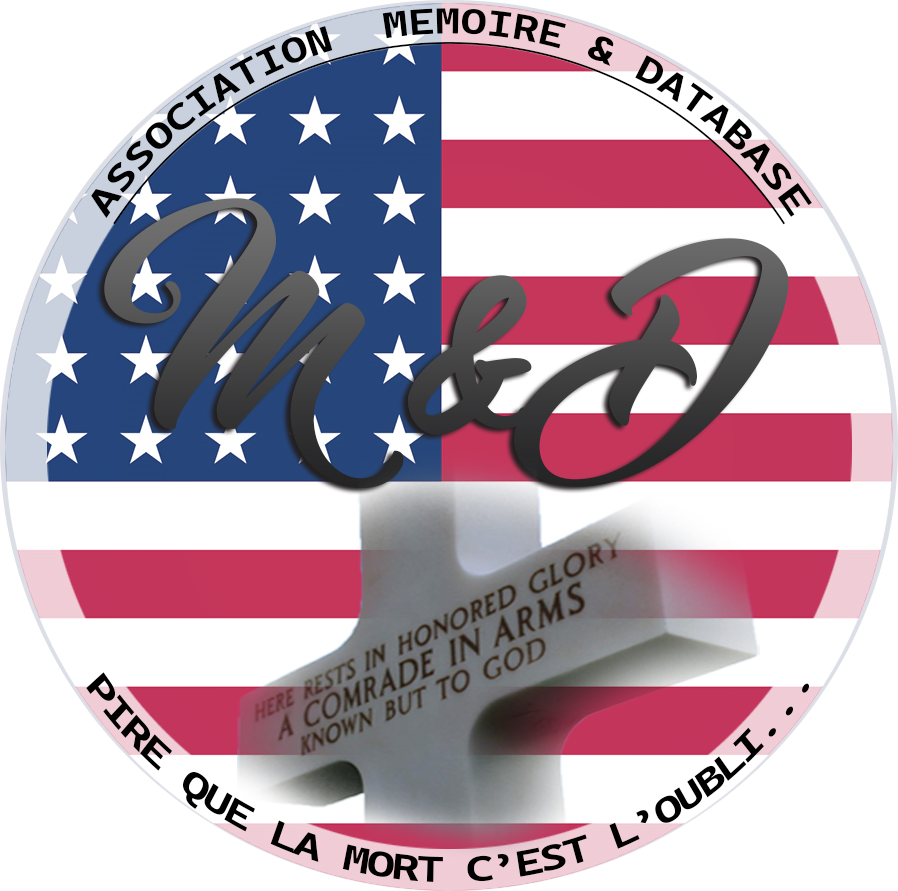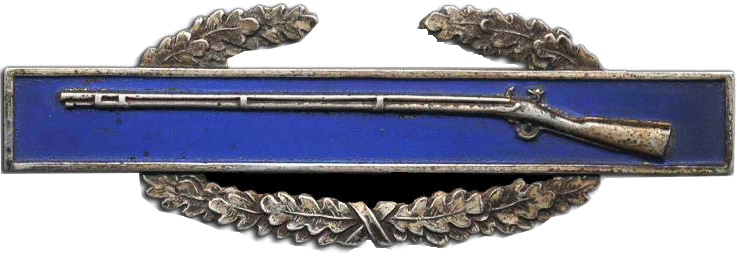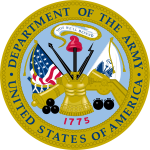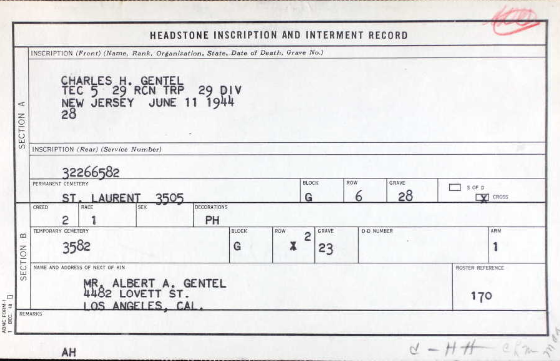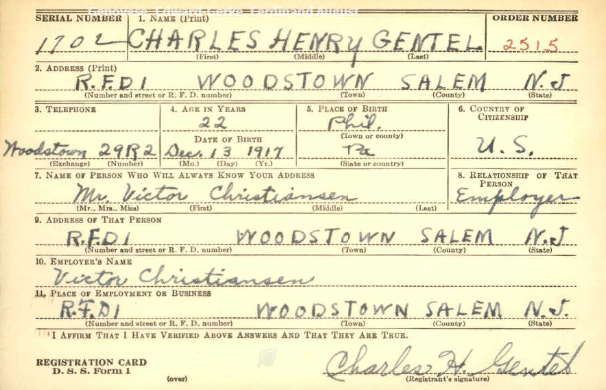|
Charles Henry GENTEL
| ||||||||||||||||||||||||
|---|---|---|---|---|---|---|---|---|---|---|---|---|---|---|---|---|---|---|---|---|---|---|---|---|
|
Source : | ||||||||||||||||||||||||
| NUMBER OF SERVICE | 32266582 | |||||||||||||||||||||||
| AGE | 26 yo | |||||||||||||||||||||||
| DATE OF BIRTH | 13 December 1917 PENNSYLVANIA | |||||||||||||||||||||||
| ENLISTMENT STATE | NEW JERSEY | |||||||||||||||||||||||
| FAMILY | Single | |||||||||||||||||||||||
| RANK | Technician Fifth Grade | |||||||||||||||||||||||
| FONCTION | ||||||||||||||||||||||||
| JOB BEFORE ENLISTEMENT | Semiskilled painters, construction and maintenance |  | ||||||||||||||||||||||
| DATE of ENLISTEMENT | 30 April 1942 Fort Dix NEW JERSEY | |||||||||||||||||||||||
| COMPANY | Company | |||||||||||||||||||||||
| REGIMENT | 29th Reconnaissance Troop | |||||||||||||||||||||||
| DIVISION | 29th Infantry Division | |||||||||||||||||||||||
| DATE OF DEATH | 11 June 1944 |
Source : C. Schuyler | ||||||||||||||||||||||
| STATUS | KIA | |||||||||||||||||||||||
| PLACE OF DEATH | ||||||||||||||||||||||||
| CEMETERY TEMPORARY |
CEMETERY TEMPORARY of Saint Laurent N°3582
| |||||||||||||||||||||||
| CEMETERY | NORMANDY AMERICAN CEMETERY of Colleville | |||||||||||||||||||||||
| GRAVE |
| |||||||||||||||||||||||
| DECORATION |
| |||||||||||||||||||||||
| ||||||||||||||||||||||||
| STORY | ||||||||||||||||||||||||
|
Source : HCGS Ohio | ||||||||||||||||||||||||
|
Charles H. Gentel and his 29th Reconnaissance troop landed on Omaha Beach in the year 1944. On this devastating day, also known as D-day, Saturday June 6th, 1944, many americans had fallen. D-day was a huge turning point in WWII, and Charles H. Gentel along with countless other brave american souls contributed to this life changing day. Mr. Gentel had passed away five days into the Omaha beach invasion, on June 11th, 1944, but his troop went on. With his death he lived a great legacy. He was part of one of the most successful invasions of all WWII history. America and the European allied powers had finally taken down a growing empire. Hitler would fall, and the world would be charged forever. Who can say that they were apart of this, Charles was. The 29th Infantry Division prepared for the war in Scotland and England for the Normandy Invasion in the months October 1942 to June 1944. Another unit of the 29th Infantry division was one of the first groups to attack the beaches at Normandy on D-day, 6 June 1944. As they landed on Omaha Beach, on D-day, fighting through their enemies machine gun fire, Charles' troop gained access through the beach and took control of Isigny-sur-Mer two days before Charles died. His group of soldiers fought in, and eventually through the Elle River and slowly traveled toward the capital of Normandy, St. Lo. At this point Charles had fallen, but his brave group moved farther into France. The american troops conquered St. Lo on July 18th, 1944 and kept taking cities over. Such as Vire on August 7th and Brest on September 18th, 1944. Now, months had past and the 29th and 116th Divisions managed to stand their ground fighting along the borders of Germany. On November 16th, 1944 the Division fought their way farther into Germany passing cities such as, Siersdorf, Setterich, Durboslar, and Bettendorf. From the months December 1944 to February 23, 1945, Chalres' Division held defensive positions along the Roer River and prepared for the offensive attack they would be giving. The attack was successful and lead the troop into Munchen-Gladbach, Germany on March 1st, 1945. The Division had finally completed their mission. They were victorious. https://charleshgentle.weebly.com/normandy.html Added by: emarches | ||||||||||||||||||||||||
|
Source : HCGS Ohio | ||||||||||||||||||||||||
Activated/Activé |
Normandy/Normandie |
| 3 Feb 1941 | Days of Combat/Jour de Combat 242 |
| Casualties/Victimes 20 620 | |
Entered Combat/Entré au combat |
|
| 6 Jun1944 D-Day | |
|
Commanding Generals/Commandants généraux Maj. Gen. Milton A. Reckord (Feb 41 - Jan 42) |
Campaigns/CampagnesNormandy (6 Jun 44 - 24 Jul 44)
|
PLAN DE ROUTE DE LA CAMPAGNE - CAMPAIGN ROUTE MAP |
|
 |
|
DIVISION CHRONICLEThe 29th Infantry Division trained in Scotland and England for the crosschannel invasion, October 1942-June 1944. Teamed with the 1st Division, a regiment of the 29th (116th Infantry) was in the first assault wave to hit the beaches at Normandy on D-day, 6 June 1944. Landing on Omaha Beach on the same day in the face of intense enemy fire, the Division soon secured the bluff tops and occupied Isigny, 9 June. The Division cut across the Elle River and advanced slowly toward St. Lo, fighting bitterly in the Normandy hedge rows. After taking St. Lo, 18 July 1944, the Division joined in the battle for Vire, capturing that strongly held city, 7 August. Turning west, the 29th took part in the assault on Brest, 25 August-18 September 1944. After a short rest, the Division moved to defensive positions along the Teveren-Geilenkirchen line in Germany and maintained those positions through October. (In mid-October the 116th Infantry took part in the fighting at the Aachen Gap.) On 16 November the Division began its drive to the Roer, blasting its way through Siersdorf, Setterich, Durboslar, and Bettendorf, and reaching the Roer by the end of the month. Heavy fighting reduced Julich Sportplatz and the Hasenfeld Gut, 8 December. From 8 December 1944 to 23 February 1945, the Division held defensive positions along the Roer and prepared for the offensive. The attack jumped off across the Roer, 23 February, and carried the Division through Julich, Broich, Immerath, and Titz, to Munchen-Gladbach, 1 March 1945. The Division was out of combat in March. In early April the 116th Infantry helped mop up in the Ruhr area. On 19 April 1945 the Division pushed to the Elbe and held defensive positions until 4 May. Meanwhile, the 175th Infantry cleared the Klotze Forest. After VE-day, the Division was on military government duty in the Bremen enclave. |
CHRONIQUE DE DIVISIONLa 29th Infantry Division s'entraîna en Ecosse et en Angleterre pour l'invasion crosschannel, d'octobre 1942 à juin 1944. En équipe avec la 1st Division, un régiment du 29th (116th Infantry) se trouvait dans la première vague d'assaut pour frapper les plages de Normandie. Le 6 juin 1944, débarquant à Omaha Beach, le même jour, face à un feu nourri de l'ennemi, la division s'empara bientôt des falaises et occupa Isigny, le 9 juin. La Division traversa la rivière Elle et s'avança lentement vers Saint-Lô, se battant amèrement dans les rangées de haies de Normandie. Après avoir pris St. Lo, le 18 juillet 1944, la division se joignit à la bataille de Vire pour s'emparer de cette ville fortement occupée, le 7 août. Tournant vers l'ouest, le 29 a pris part à l'assaut sur Brest, 25 août-18 septembre 1944. Après un court repos, la division a déménagé à des positions défensives le long de la ligne Teveren-Geilenkirchen en Allemagne et a maintenu ces positions jusqu'en octobre. (À la mi-octobre, le 116e régiment d'infanterie prit part aux combats à Aix-la-Chapelle.) Le 16 novembre, la division commença sa route vers la Roer, traversant Siersdorf, Setterich, Durboslar et Bettendorf, et atteignant la Roer par la fin du mois. Les combats intenses ont réduit Julich Sportplatz et le Hasenfeld Gut, le 8 décembre. Du 8 décembre 1944 au 23 février 1945, la division occupe des positions défensives le long de la Roer et se prépare à l'offensive. L'attaque a sauté à travers le Roer, le 23 février, et a porté la Division par l'intermédiaire de Julich, Broich, Immerath, et Titz, à Munchen-Gladbach, le 1er mars 1945. La Division était hors combat en mars. Au début du mois d'avril, le 116th Infantry a aidé à nettoyer la région de la Ruhr. Le 19 avril 1945, la division pousse vers l'Elbe et occupe des positions défensives jusqu'au 4 mai. Pendant ce temps, le 175th Infantry a dégagé la forêt de Klotze. Après le jour de la victoire, la division était en service militaire dans l'enclave de Brême. |
| SOURCE INFORMATION & PHOTO | Armydivs.squarespace.com |
|---|
| SOURCE INFORMATION & SOURCE PHOTO | Pascal Guihard - Findagrave.com - Abmc.gov - Aad.archives.gov |
|---|---|
| PROGRAMMER | Henri, Garrett, Clive, Frédéric & Renaud |


